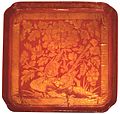Файл:Red lacquer tray with gold engraving, Song Dynasty.jpg

Розмір при попередньому перегляді: 633 × 600 пікселів. Інші роздільності: 253 × 240 пікселів | 507 × 480 пікселів | 811 × 768 пікселів | 1081 × 1024 пікселів | 2060 × 1952 пікселів.
Повна роздільність (2060 × 1952 пікселів, розмір файлу: 2,2 МБ, MIME-тип: image/jpeg)
Історія файлу
Клацніть на дату/час, щоб переглянути, як тоді виглядав файл.
| Дата/час | Мініатюра | Розмір об'єкта | Користувач | Коментар | |
|---|---|---|---|---|---|
| поточний | 09:43, 18 вересня 2008 |  | 2060 × 1952 (2,2 МБ) | Yug | image improvements |
| 19:33, 30 червня 2008 |  | 3072 × 2304 (3,34 МБ) | PericlesofAthens | {{Information |Description=A Chinese red lacquer tray over wood with engraved golden foil, from the Song Dynasty (960–1279 AD), dated 12th to early 13th century. In China, the gold-engraving technique is called ''qiangjin''. It has existed since rou |
Використання файлу
Така сторінка використовує цей файл:
Глобальне використання файлу
Цей файл використовують такі інші вікі:
- Використання в bo.wikipedia.org
- Використання в en.wikipedia.org
- Використання в fr.wikipedia.org
- Використання в id.wikipedia.org
- Використання в is.wikipedia.org
- Використання в it.wikipedia.org
- Використання в ml.wikipedia.org
- Використання в nl.wikipedia.org
- Використання в pl.wikipedia.org
- Використання в ro.wikipedia.org
- Використання в ru.wikipedia.org
- Використання в sk.wikipedia.org
- Використання в th.wikipedia.org
- Використання в vi.wikipedia.org
- Використання в zh.wikipedia.org

